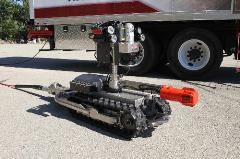CW2020 Employee Newsletter Vol. 5, No. 1
The City of Columbia owns and operates a sanitary sewer collection system of roughly 118 miles of major gravity sewer lines (from 15- to 60- inches in diameter), approximately 13 miles of major force mains, seven major pump stations, and hundreds of manholes. Assessment of the major components of the wastewater collection and transmission system (WCTS) is currently underway as required by the Continuing Sewer Assessment Program (CSAP). A key piece of this assessment is a field condition assessment of the major gravity sewer pipelines.
Contractors are performing the initial assessment of the major gravity sewer lines using two methods. Inspections of the 15- to 30-inch diameter pipelines are utilizing video inspection, including both closed circuit television (CCTV) and zoom camera methods, while pipelines 36-inches in diameter and larger are using a multi-sensor inspection. The multi-sensor inspection employs traditional CCTV video in combination with other sensor technologies to provide a comprehensive assessment of the pipeline condition that is more detailed than visual inspection alone. For this project, the multi‐sensor inspection includes the following methods:
inspection, including both closed circuit television (CCTV) and zoom camera methods, while pipelines 36-inches in diameter and larger are using a multi-sensor inspection. The multi-sensor inspection employs traditional CCTV video in combination with other sensor technologies to provide a comprehensive assessment of the pipeline condition that is more detailed than visual inspection alone. For this project, the multi‐sensor inspection includes the following methods:
- CCTV – Detects structural defects and inflow and infiltration sources including cracking, grease buildup, lining tears, etc., which can be seen visually.
- Lidar Profiling/Laser Imaging – Detects corrosion or deformed pipe above the water surface.
- Sonar Profiling – Measures sediment below the water surface.
- Hydrogen Sulfide Measurement – Measures the parts per million (ppm) of hydrogen sulfide gas present.
Almost 55 percent of the 622,000 linear feet of major gravity pipeline has been inspected and the data reviewed. Early results show a large variety of defects between basins and across the system. Examples include high infiltration in areas along the Saluda River and a large number of structural issues in older clay pipe downtown.
In addition to determining the initial condition of the major pipelines, a criticality rating is being assigned to each pipe based on quantity of flow, proximity to bodies of water, transportation impacts, and accessibility. Continuing assessment of the major gravity sewer pipelines will be prioritized by evaluating pipe condition (probability of failure) in combination with criticality (consequence of failure). Those pipes in the poorest condition with the highest criticality will be slated for rehabilitation and a schedule for continuing condition assessment will be determined for each pipe by evaluating condition and criticality.
These results will be used in conjunction with major pump station, manhole, and force main assessments to determine the overall condition of the City’s WCTS and act as a basis for asset management moving forward. Fully understanding the system condition will better allow the City to plan for the cost and timing of future needs and to efficiently maintain the desired level of service for its customers.